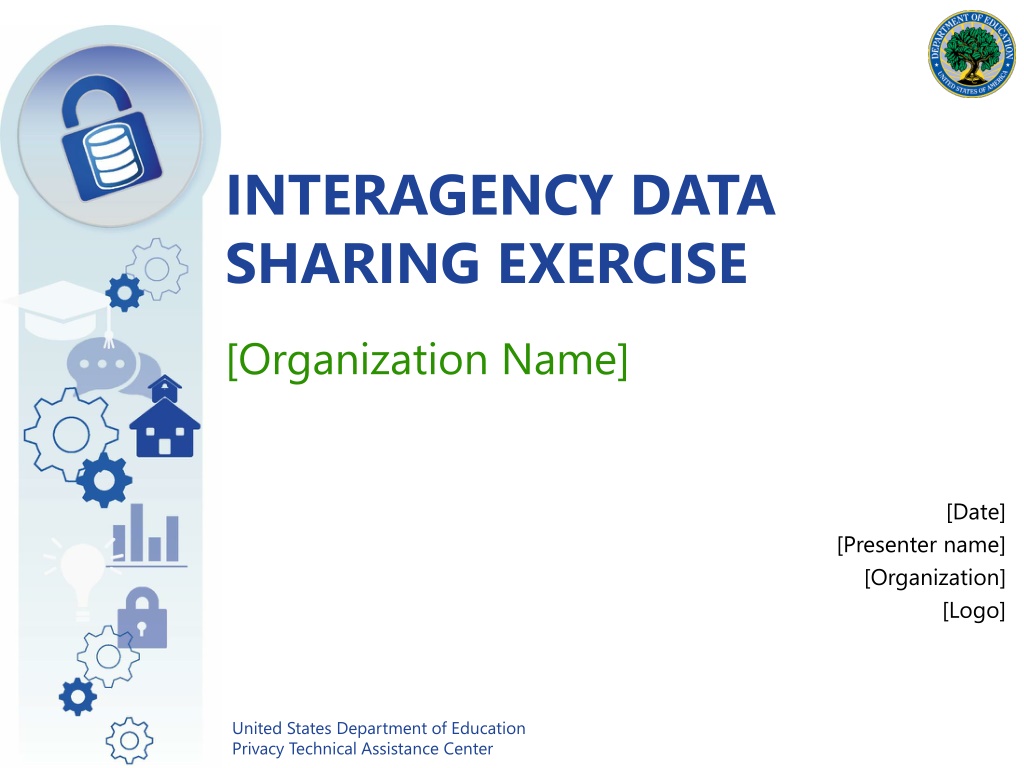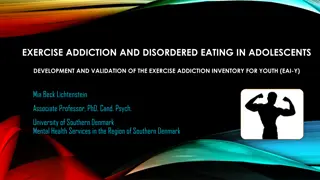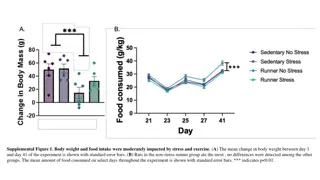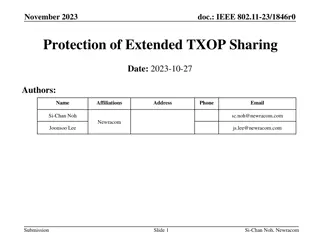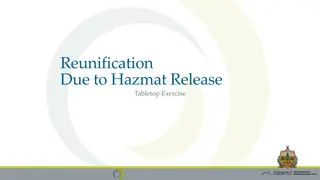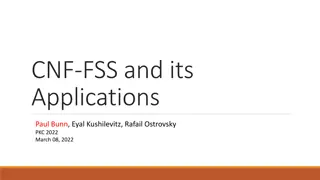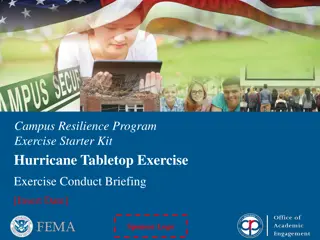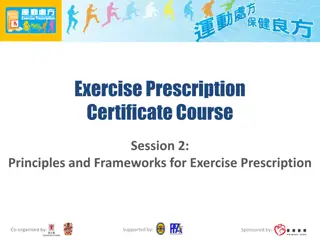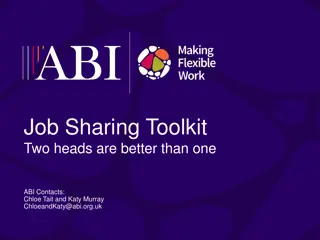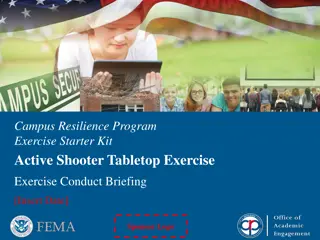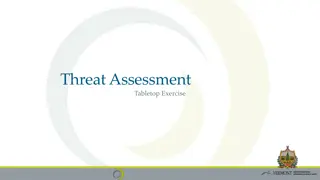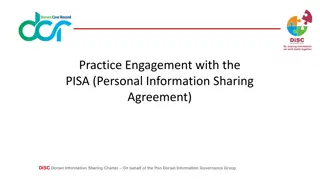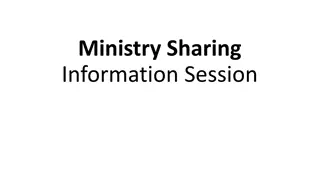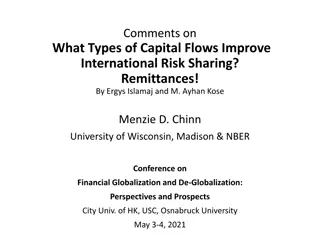Interactive Data Sharing Exercise by US Department of Education
This interactive exercise conducted by the United States Department of Education's Privacy Technical Assistance Center involves a tabletop simulation of a data breach scenario among organizations sharing student data. Participants take on decision-making roles to respond to evolving challenges and uncover the incident's details step by step. Recommendations emphasize considering diverse perspectives, preparing for uncertainties, and strategically planning resources. Key considerations include communication strategies, response planning, and team composition for effective incident management.
Download Presentation

Please find below an Image/Link to download the presentation.
The content on the website is provided AS IS for your information and personal use only. It may not be sold, licensed, or shared on other websites without obtaining consent from the author. Download presentation by click this link. If you encounter any issues during the download, it is possible that the publisher has removed the file from their server.
E N D
Presentation Transcript
INTERAGENCY DATA SHARING EXERCISE [Organization Name] [Date] [Presenter name] [Organization] [Logo] United States Department of Education Privacy Technical Assistance Center 2
DATA SHARING EXERCISE Tabletop exercise that simulates a data breach scenario between organizations that share student data. Intended to put you in the shoes of critical decision-makers who have just experienced a data breach. 2 United States Department of Education, Privacy Technical Assistance Center 2
DATA SHARING EXERCISE (CONTINUED) You will be divided into teams to react and respond to the scenario. Over time, the scenario will be more fully revealed, and you will discover more about what happened. 2 United States Department of Education, Privacy Technical Assistance Center 3
RECOMMENDATIONS Think of this from a wide perspective, and consider all the angles. At the end of each segment, and along the way, we will be presented with a series of questions (like a choose-your-own- adventure novel). Don t be afraid to challenge the answer. This is an exercise in navigating the incident. 2 United States Department of Education, Privacy Technical Assistance Center 4
BE PREPARED FOR THE UNEXPECTED! 2 United States Department of Education, Privacy Technical Assistance Center 5
SUGGESTIONS Think about each of the roles needed in your organization (for example, public information officer, data system leadership, attorney, auditors, etc.) The full extent or impact of a data breach is rarely known up front. Do your best to anticipate what might happen, but don t get ahead of yourself. 2 United States Department of Education, Privacy Technical Assistance Center 6
CONSIDERATIONS As we proceed, think about the following: 1. Public and Internal Communications/Messaging. Develop the message(s) you will deliver to your staff, students, parents, the media, and the public. 2. Response Plan. Outline how your agency will approach the scenario and what resources you will mobilize. Describe who will compose your response team. Identify goals and a timeline for your response. 2 United States Department of Education, Privacy Technical Assistance Center 7
THE SCENE South Westerland School District ~6000 students 5 Schools Decentralized IT with schools managing their own IT infrastructure SIS is at the district Close relationships with local community college and other postsecondary institutions 2 United States Department of Education, Privacy Technical Assistance Center 8
THE SITUATION Daniella Smith is a 17-year-old high school senior who is currently dually-enrolled at the local community college for advanced mathematics courses for which she will receive credit. It is now the end of May, and she has recently completed Calculus II. She is planning to matriculate in the fall semester at the community college. 2 United States Department of Education, Privacy Technical Assistance Center 9
GRADES The high school has requested her grades from community college so that she can receive credit toward her graduation requirements. The high school maintains a close partnership with the community college. To facilitate faster data exchange, the schools implemented a file transfer system that is shared by the two entities and managed by the local school district. 2 United States Department of Education, Privacy Technical Assistance Center 10
THE ALLEGATION Within a day of the grades being posted, Daniella s parents call the school and complain because their daughter is being cyber-bullied on social media by her former college classmates about failing her final exam in Calculus II. 2 United States Department of Education, Privacy Technical Assistance Center 11
THE PORTAL Trying to get to the bottom of this, Daniella logs into the high school portal and checks her grades. She has a failing grade for her calculus final! She denies having any trouble with Calculus II and doesn t understand how this could happen as she is sure she did well on the test. She is heartbroken that her reputation as a perfect student has been sullied. 2 United States Department of Education, Privacy Technical Assistance Center 12
INSTRUCTIONS 1. Gather with your team. 2. Go over the scenario carefully. What do you know? What don t you know? 3. Begin building your response. Elect a team member to take notes. This exercise works best if approached as a murder mystery game. The more you synthesize the information and role play, the more useful the exercise becomes. 2 United States Department of Education, Privacy Technical Assistance Center 13
INSTRUCTIONS (CONTINUED) 4. During the scenario, you will receive additional information about the breach. Read each of these updates as the scenario unfolds. 5. We will occasionally pause to discuss where we are, and we will eventually give a press conference. 2 United States Department of Education, Privacy Technical Assistance Center 14
Questions? 2 United States Department of Education, Privacy Technical Assistance Center 15
WORK PERIOD #1 10 Minutes 2 United States Department of Education, Privacy Technical Assistance Center 16
WHEREAREWE? Daniella is a dually enrolled student. The community college is providing her grades back to the high school. She apparently failed her college Calculus II course. She is being cyber-bullied on social media for her failing grades. 2 United States Department of Education, Privacy Technical Assistance Center 17
SCENARIO UPDATE #1 A look at the file transfer site reveals nothing out of the ordinary, it seems that the transfers occurred as normal. The site uses File Transfer Protocol (FTP) and requires a username and password to log in. Only certain approved users at the school district and at the community college have permission to access the file transfer server. 2 United States Department of Education, Privacy Technical Assistance Center 18
FTP index 2 United States Department of Education, Privacy Technical Assistance Center 19
SCENARIO UPDATE #1 (CONTINUED FROM SLIDE 18) Daniella s professor for Calculus II confirms that she did not in fact fail her final exam; in fact, she had a perfect score! She confirms that the grades recorded in the grade book reflect the correct grade and is unable to explain why there was a failing grade that was referenced on the cyber bullying incident on social media. 2 United States Department of Education, Privacy Technical Assistance Center 20
SCENARIO UPDATE #1 (CONTINUED FROM SLIDE 20) John, who is the person responsible for sending the records from the college to the district, also confirms that the grades are correct in their system. 2 United States Department of Education, Privacy Technical Assistance Center 21
NOW WHEREAREWE? 1. Is this a matter of concern? Or just a mistake? What could be going on here? 2. How could records differ so drastically between the organizations? Should you address this as a security incident? If so, at which organization? 3. What steps should you take next? Be specific. 4. What do you tell the parents? 2 United States Department of Education, Privacy Technical Assistance Center 22
WORK PERIOD #2 10 Minutes 2 United States Department of Education, Privacy Technical Assistance Center 23
WHEREAREWE NOW? Daniella is dually enrolled in community college and does well. Her grades at the K-12 side don t reflect the correct grade. At the same time she is being bullied by some of her classmates at college for the errant grades at K-12 school, even though the grades at college are correct. 2 United States Department of Education, Privacy Technical Assistance Center 24
SCENARIO UPDATE #2 In the course of the investigation it is determined that John s account logged into the file transfer site twice. Once initially and then later Sunday, overwriting the file containing Daniella s grade some time after the official transcript file was sent. Copies of the original file show that the grades were initially correct and were then changed when the subsequent file was uploaded a few days later. 2 United States Department of Education, Privacy Technical Assistance Center 25
SCENARIO UPDATE #2 (CONTINUED FROM SLIDE 25) The online bullying began the day after the second file was uploaded to the transfer server. Two of the main perpetrators of the bullying on Daniella s social media account are computer science majors who were also in her Calculus II class, with somewhat less stellar grades. 2 United States Department of Education, Privacy Technical Assistance Center 26
SCENARIO UPDATE #2 (CONTINUED FROM SLIDE 26) One of the two is a student worker helping the IT department. Logs from the affected server show that the accesses came from two different IP addresses, the first one at the college and the second from the local campus coffee shop. 2 United States Department of Education, Privacy Technical Assistance Center 27
WORK PERIOD #3 10 Minutes 2 United States Department of Education, Privacy Technical Assistance Center 28
WHERE ARE WE AT THIS TIME? 1. Is there foul play here? What, if anything, can we do at this point? 2. Since the bullies seem to know Daniella s grades, is this a data breach? Whose responsibility is it, the district or the college? 3. Do the facts yield a clear picture of what happened? What can you tell Daniella s parents? 4. What steps should you take next? Be specific. 2 United States Department of Education, Privacy Technical Assistance Center 29
SCENARIO UPDATE #3 Investigators at the community college question the students responsible for the bullying. One of the two admits that it was a prank to get back at Danielle who is much younger and getting far better grades. 2 United States Department of Education, Privacy Technical Assistance Center 30
SCENARIO UPDATE #3 (CONTINUED FROM SLIDE 30) The cooperating bully explains that his friend performed a Man in The Middle (MitM) attack on the college s office network. This enabled them to sniff the authentication portion of John s session with the district s file server and obtain his password. 2 United States Department of Education, Privacy Technical Assistance Center 31
THE MITM ATTACK Unencrypted Password INTERNET John s computer (Registrar s Office) District Server Bully s Computer 2 United States Department of Education, Privacy Technical Assistance Center 32
SCENARIO UPDATE #3 (CONTINUED FROM SLIDE 31) They then used that information to access and change the file John placed on the server, re- uploading it with altered grades using the open access point at the coffee shop next to the dorm. 2 United States Department of Education, Privacy Technical Assistance Center 33
DEVELOPINCIDENTRESPONSE PLAN Use your notes from the scenario discussion. Identify an incident response team (for example, CIO, Data Coordinator, IT Manager, legal counsel). Outline the steps to identify the source of the infection and curtail the spread, catalog the data affected, and identify how it occurred. What preventative corrective actions should you implement? 2 United States Department of Education, Privacy Technical Assistance Center 34
WORK PERIOD #4 10 Minutes 2 United States Department of Education, Privacy Technical Assistance Center 35
UNVEIL YOUR RESPONSE PLAN Take us through your response plan. Include the who, what, when, and how of your activities. What were the driving factors in your decision- making process? Did your plan evolve as the scenario became clearer? How? How should you prepare to enable a prompt reaction to a potential breach? 2 United States Department of Education, Privacy Technical Assistance Center 36
WRAP-UP The attack happened at the college, but the system was at the district. Who is responsible? Has a crime been committed? Do you contact the police? Is this a data breach in your state? Keep in mind that data breach is often a defined term. What could either organization have done to avoid this? 2 United States Department of Education, Privacy Technical Assistance Center 37
